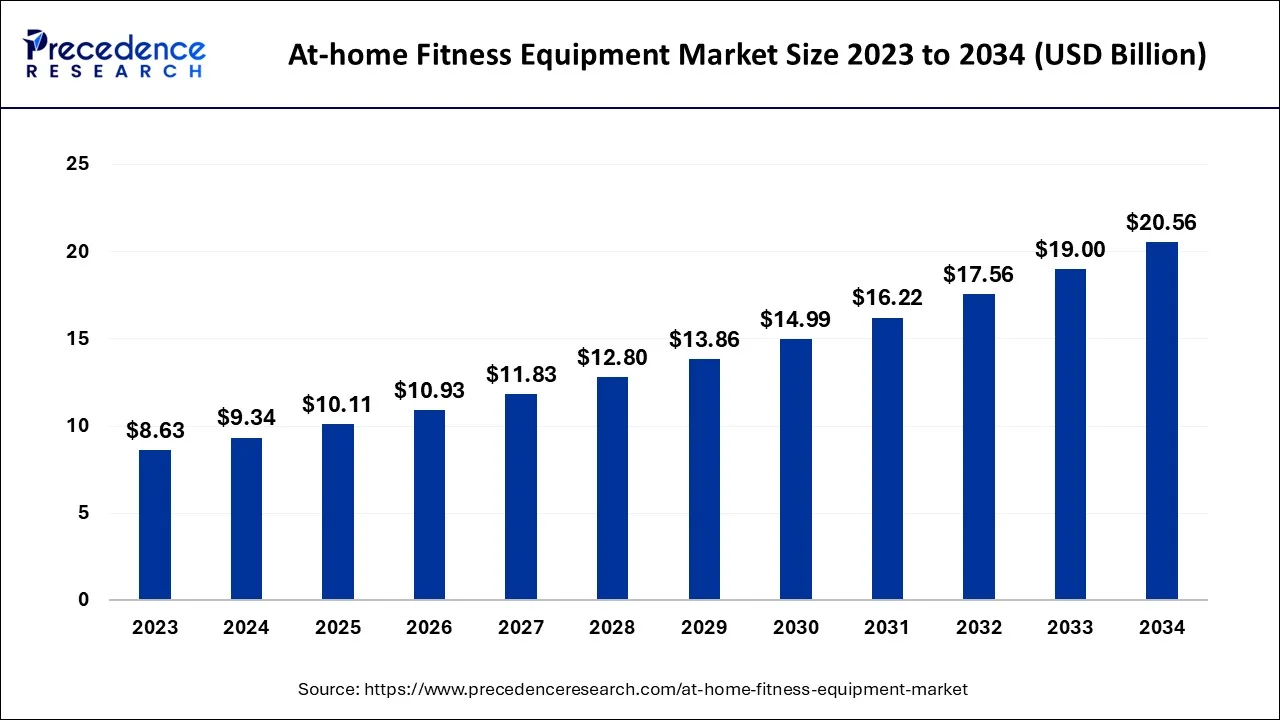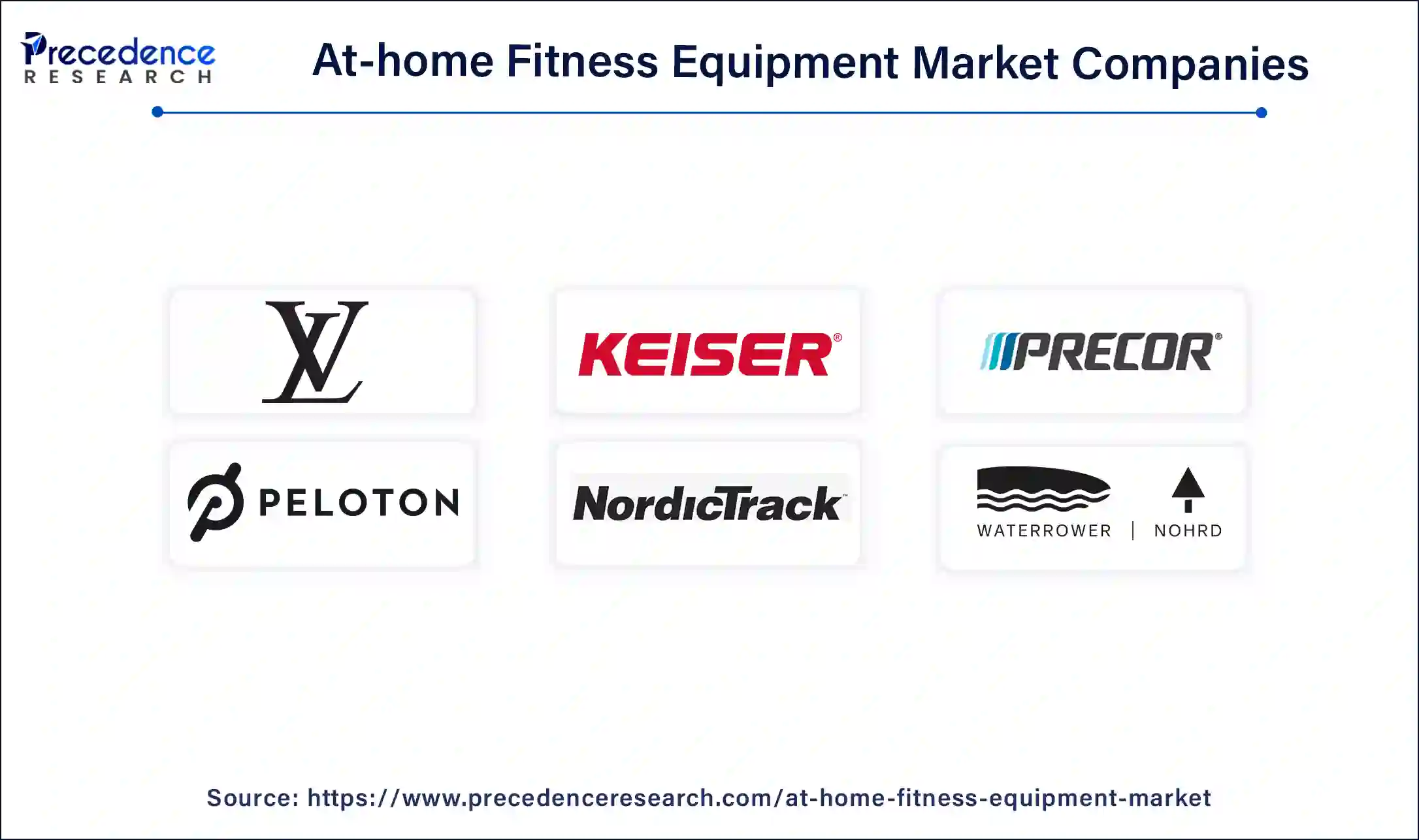October 2024
The global at-home fitness equipment market size is calculated at USD 9.34 billion in 2024, grew to USD 10.11 billion in 2025 and is expected to surpass around USD 20.56 billion by 2034, growing at a solid CAGR of 8.21% during the forecast year.
The global at-home fitness equipment market size accounted for USD 9.34 billion in 2024 and is projected to reach around USD 20.56 billion by 2034, expanding at a CAGR of 8.21% from 2024 to 2034. The demand for fitness equipment is increasing due to the rising awareness about health and wellness. Furthermore, the rising technological advancements in indoor fitness equipment are boosting the growth of the at-home fitness equipment market.

At-home fitness equipment refers to fitness equipment specifically designed for use in household settings. This equipment includes spin bikes, treadmills, upright bikes, and cross containers. The at-home fitness equipment has various advantages such as convenience and time savings, is cost-effective in the long run, provides comfort and privacy due to its indoor settings, and offers a variety of workouts with hygiene. The demand for indoor fitness equipment is increasing due to the rising concern of infection, owing to the use of equipment by other people in the gym. Moreover, a busy lifestyle encourages people to work out at home, thus boosting the demand for at-home fitness equipment.
How Can AI Impact the At-home Fitness Equipment Market?
Integrating AI into fitness equipment can provide personalized workout plans, real-time form correction, and customized nutrition advice. Wearable technology integration into fitness helps provide data and helpful insights about health. AI's predictive analytics has the ability to track user and equipment performance, thus enhancing user satisfaction and experience.
| Report Coverage | Details |
| Market Size by 2034 | USD 20.56 Billion |
| Market Size in 2024 | USD 9.34 Billion |
| Market Growth Rate from 2024 to 2034 | CAGR of 8.21% |
| Largest Market | North America |
| Base Year | 2023 |
| Forecast Period | 2024 to 2034 |
| Segments Covered | Product, Distribution Channel, End-user, Price Point, and Regions |
| Regions Covered | North America, Europe, Asia-Pacific, Latin America and Middle East & Africa |
Rising prevalence of lifestyle-related diseases and awareness about health and wellness
The preference for at-home fitness equipment is rising worldwide. This is mainly due to the increasing prevalence of lifestyle-related diseases. A sedentary or inactive lifestyle is the main cause of lifestyle-related diseases like obesity, hypertension, type 2 diabetes, and cardiovascular diseases. Moreover, increasing awareness about health and wellness among the young population encourages them to engage in physical activities, like yoga, thus boosting the demand for at-home fitness equipment. The rising trend of bodybuilding among youngsters further contributes to at-home fitness equipment market expansion.
High cost associated with fitness equipment
Fitness equipment is costlier, and not everyone can afford it. This may deter consumers, especially people with middle and low incomes, from purchasing it. Furthermore, some equipment requires regular maintenance, which adds to maintenance costs, thus restraining the overall market.
Advancements in the fitness equipment
Advancements in fitness equipment led to smart gadgets revolutionizing the overall fitness concept. Standard gym equipment like treadmills evolved into smart, data-driven machines. However, the evolution of smart fitness gadgets, like smartwatches and wearable fitness trackers, allows consumers to monitor and track their fitness insights in real-time, thus boosting their acceptance.
The cardiovascular training equipment segment is expected to expand at a significant growth rate in the near future. This is due to the rising awareness about health and the increasing cases of cardiovascular disease due to changing lifestyle habits, eating habits, lower physical activities, and other factors. This, in turn, boosts the adoption of cardiovascular training equipment, such as treadmills, stationary cycles, rowing machines, and ellipticals. These machinery are specially designed to improve cardiac conditions.
The regular use of cardiovascular training equipment enhances the strength of the heart muscles, minimizes the risk of heart disease, and increases blood circulation. Consistency in workout helps increase endurance and stamina, burn fats, help in weight management, reduce stress, and improve mood. The cardiovascular training equipment provides versatility in workouts with higher convenience and accessibility.
The free weight segment is projected to grow rapidly in the coming years. Free weights are not machines like equipment that are fixed on a particular weight or format. They include kettlebells, dumbbells, and medicine balls. These are considered the best for home workouts and the most effective solution. They do not require maintenance and are better for building muscles, functional fitness, burning more calories, and improving balance.
The dealers segment accounted for the largest share of the at-home fitness equipment market in 2023. The rising preference for buying fitness equipment from dealers contributed to the growth of the segment. Dealers offer a great variety of fitness equipment in various shapes and sizes as per requirement. They provide easy access and knowledge and instructions about the equipment. Furthermore, dealers have distribution centers such as online marketplaces, departmental stores, specialty fitness retailers, and authorized distributors, which provide greater varieties with attractive discounts.
The online segment is expected to grow at the fastest rate in the market during the forecast period. This is primarily due to the expansion of e-commerce businesses worldwide. The preference for online shopping is increasing, as online stores allow consumers to shop from home. These stores provide access to a wide range of products with schemes like EMI options and attractive discounts. The rising inclination of the younger population toward online shopping and the rising number of e-commerce platforms further drive the segment.
The apartments segment led the market in 2023. The apartment's gym or fitness center is considered basic and essential amenities. Having a gym at a residential apartment or building eliminates the need to commute to a gym, which makes it easier for residents with busy schedules. The rising construction of residential apartments significantly contributed to segmental growth.
The households segment is anticipated to grow at a rapid pace in the at-home fitness equipment market over the studied period. The rising interest in active living among youngsters and the older population, combined with their busy lifestyles, encourages them to set up fitness room. This, in turn, boosts the demand for fitness equipment specially designed for home settings, thus fueling the segment.
The mid-price point segment dominated the at-home fitness equipment market in 2023. The growth of the segment is attributed to the rising consumer preference for high-quality and cost-effective fitness equipment for their home settings. The mid-price fitness equipment has wide varieties and a number of brands. Consumers often prefer quality equipment without going out of budget, which contributed to the segment dominance.
The low-price point segment is projected to witness significant growth in the market during the forecast period. The demand for low-priced fitness equipment is rising for household purposes. Thus, several leading fitness equipment providers are designing and launching low-priced fitness equipment with enhanced quality to meet consumers' increasing needs.
North America is leading the market in terms of market share. This is primarily due to the rising health awareness and the increasing trend of fitness and bodybuilding among the population. Moreover, the rising cases of obesity, cardiovascular health conditions, and several health issues due to sedentary lifestyles and unhealthy eating habits, such as consumption of junk food, smoking, and drinking alcohol, encourage people to engage in fitness activities and live healthy lifestyles. This, in turn, is boosting the demand for fitness equipment, significantly driving the market in the region.
Europe is anticipated to expand at a significant CAGR during the forecast period. Rising awareness about wellness among people and the rising instances of lifestyle-related diseases, such as high blood pressure, diabetes, obesity, and cardiovascular diseases, due to unhealthy lifestyles are driving the growth of the at-home fitness equipment market in the region.

Segments Covered in the Report
By Product
By Distribution Channel
By End-user
By Price Point
By Geography
For inquiries regarding discounts, bulk purchases, or customization requests, please contact us at sales@precedenceresearch.com
No cookie-cutter, only authentic analysis – take the 1st step to become a Precedence Research client
October 2024
January 2025
January 2025
February 2025